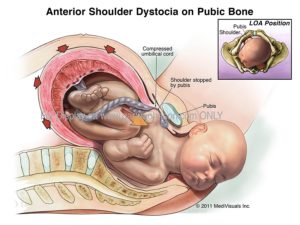injury case consultation
Available 24/7
In normal childbirth, the baby moves slowly but surely down the birth canal head first. Shoulder dystocia is what happens when the baby’s head passes the mother’s pubic bone, but the baby’s shoulder gets caught at that spot. Normally the rest of the child’s body will be born within a minute after the head. The “turtle sign” indicating the condition is when the baby’s head retracts back into the birth canal.

Shoulder dystocia delays the full birth of the baby, who will likely need help from the obstetrician or midwife to release the shoulder from this obstruction. In cases where injuries occur due to delayed or difficult births like this, reaching out to personal injury lawyers in Lexington can help families explore their legal options.”
Shoulder dystocia is a medical emergency. When it occurs, the baby’s shoulder needs to be released quickly so the baby can come out and start breathing on its own. There are a number of ways to do this, depending on the circumstances.
Shoulder dystocia happens in about 1 in 150 non-Caesarean births of vaginal delivery.
While larger babies are somewhat more likely than small babies to experience shoulder dystocia, it’s not often possible to predict this will happen. Risk factors for the mother besides infant size include shoulder dystocia during a previous childbirth, diabetes, high body-mass index, induced labor, long labor, and if forceps were used.
Few babies experience shoulder dystocia. Of those that do, about 90 percent will experience no effects at all. About one in ten babies with shoulder dystocia will also have some stretching of the nerves in their neck. This is called a brachial plexus injury (BPI), which can also be caused by a Caesarean section. This sort of injury might cause a loss of arm movement for a short time. “Erb’s palsy” is the most common type of BPI. It is usually temporary with movement returning within hours or days.
Although unlikely, shoulder dystocia can result in fractures of the baby’s arm or shoulder. In a few rare cases, the baby can suffer brain damage from lack of oxygen while birth is delayed.
Birth injuries are often preventable. Routine tests and monitoring during delivery allow medical providers to anticipate and deal with problems. It is the duty of your obstetrician to exercise the degree of care and skill ordinarily exercised by a reasonably competent obstetrician in similar circumstances. That includes the duty to anticipate problems. If the obstetrician fails in this duty, there can be catastrophic results to the baby’s safety.
If your child was born with a birth defect, speak to a Kentucky birth injury lawyer for legal assistance.